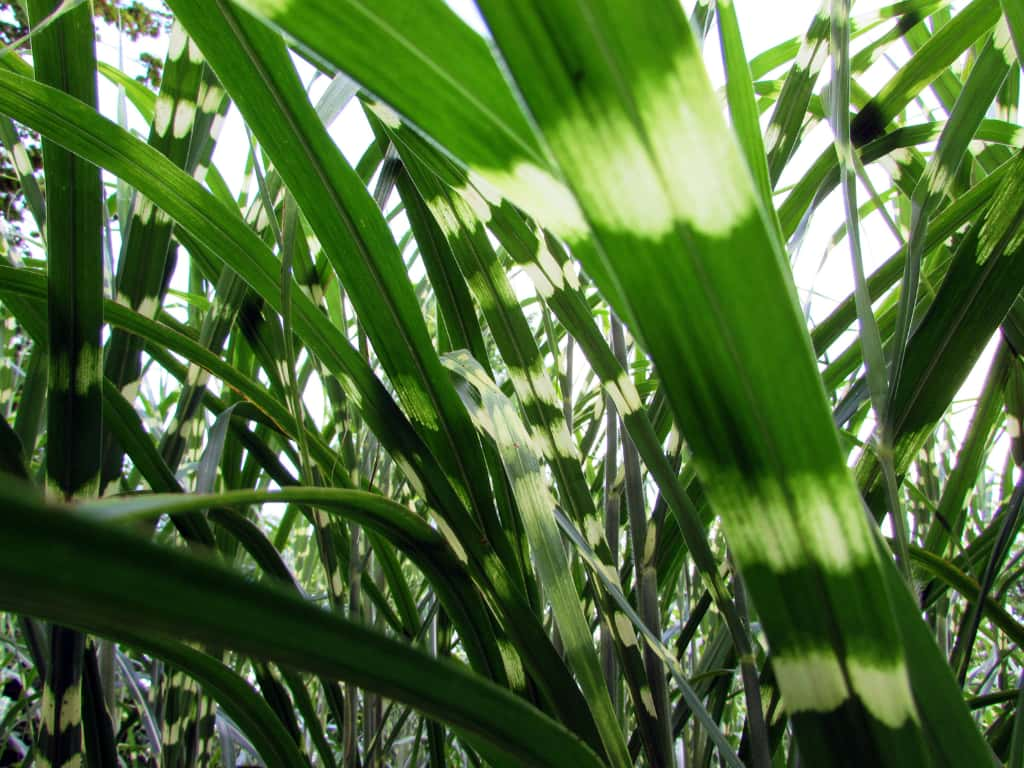In this guide, we break down some of the ways to kill tiger grass so you can regain control of your garden.
What is tiger grass?
Tiger grass is a tall, clumping ornamental grass that is becoming increasingly popular in Australian gardens. The plant’s green and yellow striped leaves resemble a tiger’s markings, giving it a unique appearance and striking for your garden.
Is tiger grass invasive?
While we don’t consider tiger grass as invasive, ornamental grasses can grow rapidly in the right conditions and cover surrounding plants. Consequently, this can cause the grass to grow out of control and possibly overwhelm your garden (which is probably why you’re reading this in the first place).
Due to the plant’s large clumps and rhizomes (underground stems), tiger grass can also become quite thick over time, making it difficult to remove or transplant.
For more information on this plant, check out our guide on tiger grass problems and how to manage the grass before it forces you to take proactive measures. Prevention is always better!
How high does tiger grass grow?
According to the International Palm Society, tiger grass can grow up to three metres in height, making it a popular choice for Australians who want to create a natural screen for privacy.
How fast does tiger grass grow?
It only takes around 18 months for tiger grass to reach its maximum height.
The fast growth of tiger grass is due to its extensive network of rhizomes, which allows it to spread quickly and efficiently. The plant’s rhizomes can also help it to access nutrients and water more easily, further contributing to its growth rate.
The negative side is that without regular maintenance and pruning, your garden can quickly turn pear-shaped and motivate you to get rid of the grass completely.
How to kill tiger grass
There are three effective ways to kill tiger grass:
- Cut and dig method
- Soil solarisation
- Herbicides
However, it is important to note that each method has its own risks to your garden and backyard. Below, we outline each of these methods and what you need to consider before using them to kill your tiger grass.
1. Cut and dig method
Although a manual and labour-intensive approach, the cut and dig method effectively kills your tiger grass with minimal harm to your garden. This process involves cutting the plant down to ground level and digging out the rhizomes (underground stems) to prevent regrowth.
To achieve this effectively, you must:
- Cut down the tiger grass: Using a pruning saw or sharp shears, cut the tiger grass down to ground level. This will make it easier to access the rhizomes and prevent regrowth.
- Dig out the rhizomes: Using a garden spade or shovel, carefully dig around the base of the plant to expose the rhizomes. Carefully remove as much of the rhizome system as possible, making sure to remove any smaller pieces or roots.
- Monitor the area: After removing the rhizomes, monitor the area carefully for any signs of regrowth. If new shoots appear, repeat the process to remove them before they can become established.
- Dispose of the plant material: Once the plant and rhizomes have been removed, properly dispose of them. We recommend avoiding compositing the grass, as it can lead to the spread of the rhizomes to other areas of the garden.
Another notable consideration is that you may need to repeat the process several times to remove the rhizomes and fully prevent regrowth. However, this is our favourite method as it does not rely on potentially harmful chemicals that could damage your garden.
2. Soil solarisation
Soil solarization is a chemical-free method to kill your tiger grass that involves using the sun’s heat to kill the plant and its rhizomes. This method is most effective if your garden has full sun and your daily temperature is around 25 degrees Celsius.
Accordingly in Australia, we recommend doing this around early spring during dry periods.
When executing soil solarisation to kill your tiger grass, you must:
- Prepare the area: Clear all debris, including leaves and sticks, and water your soil thoroughly. Be sure to level the area and remove any rocks or large debris.
- Cover the area: Cover the entire area with a clear plastic sheet or tarp. Ensure the plastic is large enough to cover the whole area and extend several feet beyond the edges to anchor it.
- Secure the edges: Use rocks or soil to secure the edges of the plastic sheet to the ground, creating an airtight seal.
- Wait for the heat: Leave the plastic in place for at least six to eight weeks, depending on the temperature and weather conditions. The heat generated under the plastic will kill the tiger grass and its rhizomes.
- Remove the plastic: After the waiting period, carefully remove the plastic sheet and dispose of it appropriately. We recommend avoiding reusing the plastic sheet, as it may have absorbed chemicals from the soil.
- Replant the area: Once the tiger grass is dead, and the area has cooled, you can start to replant with your desired selection.
When using the soil solarisation method, you must understand that the process also kills beneficial organisms in your soil. Accordingly, we recommend using this method sparingly and only in areas where tiger grass has become a problem.
3. Herbicides
While herbicides can effectively control tiger grass, it is important to note that they can also negatively impact other plants and the environment. Before using herbicides, we recommend considering the alternative control methods mentioned above.
If you believe that herbicides are absolutely necessary for your garden, take the following steps to ensure you don’t cause harm to surrounding plants:
- Choose an appropriate herbicide: You must select a broad-spectrum herbicide that is designed to kill grasses, such as glyphosate or fluazifop-p-butyl. It is important to carefully follow the instructions on the label and use the appropriate protective gear when handling and applying the herbicide.
- Apply the herbicide: Spray the herbicide onto the leaves and stems of the tiger grass, making sure to cover the entire plant. Avoid spraying nearby plants, as the herbicide may also kill them. You can try using a spray bottle for a more targeted approach.
- Monitor the plant: After applying the herbicide, you should monitor the tiger grass for signs of wilting or yellowing.
- Repeat as necessary: Repeat the process if the tiger grass does not die off completely after the first application. Note that it may take several applications and a handful of weeks to kill the plant fully.
- Dispose of the plant carefully: Once the tiger grass is dead, carefully remove it from your garden and dispose of it appropriately. We recommend not composting the plant, as the herbicide may persist in the soil and cause harm to other plants.
We want to stress that herbicides should only be used as a last resort. Ensure that you always follow instructions on the product labeling carefully and wear protective gear when handling and applying the herbicide!
What to do with your trimmings?
Now that your tiger grass is dead, the next important question is: what do I do with the trimmings?
Here are a few effective methods:
- Municipal waste disposal: You can dispose of tiger grass trimmings through your local council’s green waste or garden waste program. Check with your local council for specific guidelines on disposal.
- Landfill: If you do not have access to a green waste program, you can dispose of tiger grass trimmings in the regular landfill waste. However, it is important to contain the trimmings in a sealed bag to prevent the spread of the plant.
- Reuse: If you have a creative streak, you could consider using your tiger grass trimmings in craft or garden projects. For example, you could use the stems to make a natural screen or fence for your garden.
How to prevent tiger grass from returning
It is important to take some precautions to ensure that tiger grass doesn’t return. Here are some steps you can take to prevent the plant from coming back:
- Remove rhizomes: Tiger grass has an extensive root system, and even a small piece of rhizome left in the soil can grow into a new plant. It is essential to remove all of the plant’s rhizomes, including small pieces, to prevent it from regrowing.
- Monitor the area: Even after you’ve removed all the visible tiger grass, it is important to monitor the area for any regrowth. If you notice any new shoots or leaves, remove them immediately.
- Plant other species: One way to prevent tiger grass from returning is to plant other species in the area. This will prevent the tiger grass from taking over the space again.
- Regular maintenance: Finally, regular maintenance of the area is key to preventing tiger grass from returning. Regularly mow and weed the area to prevent any plants from getting a foothold.
Following these steps can prevent tiger grass from returning and keep your garden or property free of this invasive plant.






